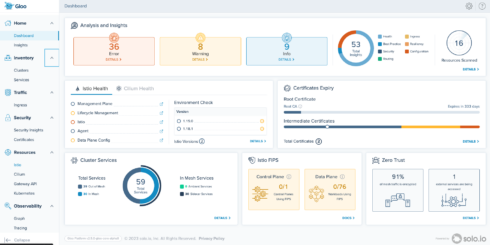
The cloud-native networking company Solo.io is introducing a new product called Gloo Mesh Core that was created to increase service mesh adoption by alleviating some of the complexities of working with the technology.
“Service mesh does have a bit of a reputation for complexity,” Tom Callway, vice president of marketing for Solo.io, told ITOps Times. “I mean, application networking sounds complicated because it genuinely is. A few years ago, service mesh was in the reserve of only a very few number of very large cloud native users with very sophisticated internal teams that could support it. But now as Kubernetes is beginning to grow as an ecosystem, and people have got more and more complex use cases, service mesh is very much the way to go.”
According to Callway, despite the complexity, Istio has really become the go-to standard for service mesh across the industry. The impetus behind Gloo Mesh Core is to try to lessen that complexity and act as a sort of Easy Button for service mesh, he explained.
With Gloo Mesh Core, users will be able to easily manage installation, security, and monitoring of their deployments.
Gloo Mesh Core customers will be able to easily update to new versions of Istio as they come out via Solo.io’s long-term support images. Other features that help simplify operations include the ability to layer Gloo Mesh Core on existing Istio deployments, a FIPS-ready build of Istio, enterprise-grade Istio support, and the ability to customize storage backends.
Observability is another area Gloo Mesh Core helps with, offering streamlined diagnostics, a single dashboard, root cause analysis and issue resolution, use of OpenTelemetry to track the health of deployments, and integration with other popular monitoring tools.
The platform also supports Ambient Mesh, which is an open-source service mesh project developed by Solo.io and Google that doesn’t rely on sidecars like most service meshes. According to Solo.io, use of Ambient Mesh can reduce overhead management costs by 90% to 99%.
According to Louis Ryan, CTO of Solo.io, there are two different versions of this offering: Gloo Mesh Core and Gloo Mesh Enterprise. He says that Gloo Mesh Core is designed for those working with individual environments, while Gloo Mesh Enterprise is better suited for customers with multiple clusters or environments.
“There’s a specific set of features you need to sit on top of the basic kind of core tenants of service mesh, to help you manage and operationalize across sets of environments,” Ryan said. “So that’s the fundamental difference. If you’re looking at Gloo Mesh Enterprise, you’ll see features there like multi-cluster and multi-network connectivity solutions that we don’t provide in Gloo Mesh Core.”








